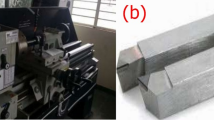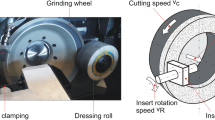Abstract
The innovative technology of cutting mineral materials with a geometrically defined cutting edge, using a band saw, needs further development and improvement as regards the joining method of the individual cutting elements. So far, the joining methods soldering and welding have caused significant problems for the cutting process. For this reason, the aim of the testing series is to prove that geometrically defined cutting elements can be joined to the saw bands through adhesive bonding. However, when using a geometrical defined cutting edge to cut mineral material, it is very important that the cutting element, which is coated with a polycrystalline diamond (PCD) layer, is positioned exactly, as readjustments are not possible later. When using soldering or welding methods, the cutting element cannot be positioned accurately at all, as the heat that evolves during these processes causes thermal deformations. Not needing high temperatures, adhesive bonding has the further advantage that the crystalline structure of the PCD element is not damaged either. Testing showed that these adhesively joined bonds hold well when cutting granite. Further research was concentrated on the temperature level during the cutting process, both with additional cooling and without. This article aims to show the potential of adhesive bonding and the resulting opportunities for the cutting process with geometrically defined cutting elements and finally concludes that further research is necessary.







Similar content being viewed by others
References
Dültgen, Brand, Kracht, Stahlhut (2009) Laserlöten von Sägeblättern. Werkstatttechnik online 99(5):359–361
Gleim (2006) Untersuchungen zum Bandsägen mit diamantbeschichteten Werkzeugen. German dissertation. University of Kassel
Haferkamp, Engelbrecht, Bunte, Cordini, Münz (2003) Laserstrahllöten von Hartmetallschneiden. Integrierte Produktion Spezial (1):55–58
Lachmund (1997) Verschleissverhalten von polykristallinem Diamant bei instationärer Beanspruchung. German dissertation. Fraunhofer Publica
Reichenbächer (2010) Trennen mineralischer Werkstoffe mit geometrisch bestimmten Schneiden. German dissertation. Universität Kassel
Reichenbächer, Scherm, Böhm (2011) Steinbearbeitung mit geometrisch bestimmter Schneide aus PCD. DIHW-Magazin (2):32–35
Reinhardt (2003) New shape of diamond segment for machining natural and artificial stone. Ind Diam Rev 63(2):16–18
Wirts-Rütters, Denkena, Schneider, Konopatzki Wloka (2011) Kleben von Schleifsegmenten auf Trennscheiben für die Gesteinsbearbeitung. DIHW-Magazin (1):44–53
Final Report AiF-Project 12792/N (2003) Entwicklung einer wärmearmen Fügetechnik für das Bewehren von Stammblättern mit Schneidsegmenten
Final Report AiF-Project 15028/N (2010) Entwicklung einer kostengünstigen und mobilen Fertigungs- und Instandhaltungstechnologie für das Bewehren von Stammblättern mit Schneidsegmenten
Final Report AiF-Project 16031/BG (2011) Klebtechnisches Verbinden von Hartstoffschneiden mit Schneideinsatzträgern für Hochleistungswerkzeuge
Author information
Authors and Affiliations
Corresponding author
Additional information
Doc. IIW-2417, recommended for publication by Commission XVI “Polymer Joining and Adhesive Technology.”
Rights and permissions
About this article
Cite this article
Kohl, D., Schwarte, S., Heise, C. et al. Adhesive joining of PCD cutting segments onto a saw band for machining mineral material. Weld World 58, 237–244 (2014). https://doi.org/10.1007/s40194-013-0101-z
Received:
Accepted:
Published:
Issue Date:
DOI: https://doi.org/10.1007/s40194-013-0101-z




